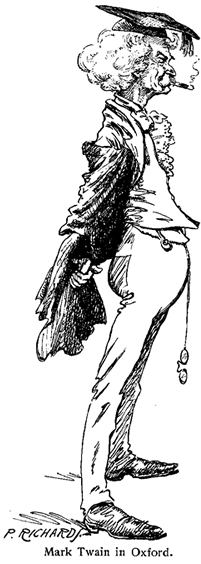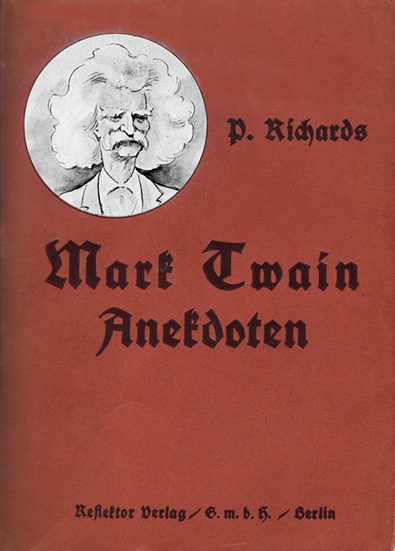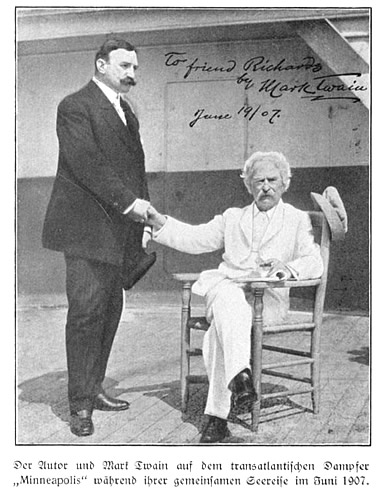In his files, Mac Donnell also had a copy of a 1933 issue of Library
Review, a journal published in Coatsbridge, Scotland with an article
written by Richards wherein he claimed, "During our many years [of]
subsequent close association, I drew hundreds of caricatures of the great
humorist." ("Reminiscences of Mark Twain," Library Review,
No. 25, Spring 1933, p. 19).
Additional searches of the newspapers and journal archives uncovered more
stories about a cartoonist named P. Richards including a story from an 1897
issue of Inland Printer which describe him as a world traveler who
was "now making a specialty in theatrical work." (Inland
Printer, Vol. 29, April - September 1897, p. 698). Newspaper reports
from California in the summer of 1897 indicated P. Richards, the famous
cartoonist from the east would be appearing on the vaudeville stage on the
west coast ("Players and Plays," Oakland Tribune, 3 July
1897, p. 1); in the fall of 1900 he was entertaining the Press Club in Omaha,
Nebraska with his "lightning caricatures ("Press Club Ready for
Its Treat, Omaha World-Herald, 30 October 1900, p. 3); and he was
again onstage in vaudeville in San Francisco in the summer of 1901 ("Amusements,"
San Francisco Chronicle, 30 June 1901, p. 22). In the fall of 1902
the New York Clipper reported that Richards, known for his rapid
sketching act on the vaudeville stages, had returned from an extensive tour
of Europe and would be accepting a position with a Chicago newspaper ("P.
Richards, Caricaturist," The New York Clipper, 4 October 1902,
p. 692).
In May 1905 The New York Clipper, the oldest theatrical journal
in America, proudly announced they had spared no expense to add cartoonist
P. Richards to their staff.
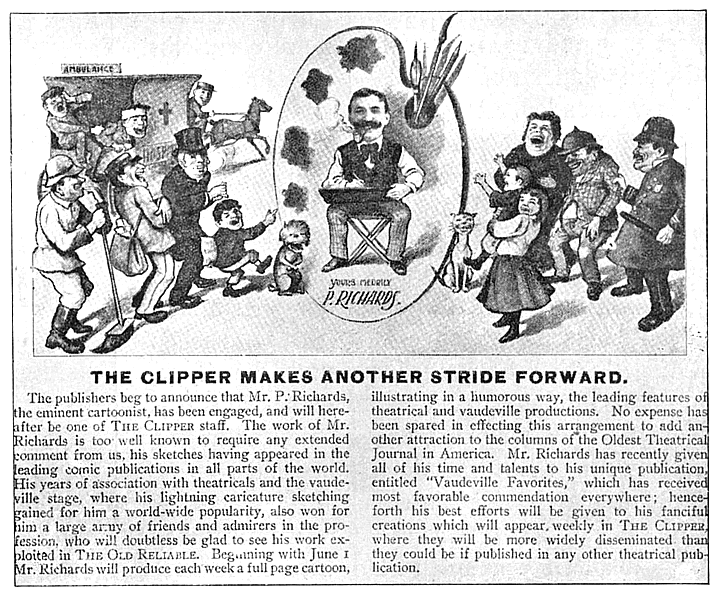
The New
York Clipper,
13 May 1905, p. 299.
Richards's cartoons and caricatures of leading vaudeville and stage performers
received a favorable response from readers and were described as being distinguished
by fine humor without sarcasm. In January 1907 the Clipper announced
the inauguration of Richards's own cartoon series "Patsy Bolivar"
and indicated Richards would take his cartoon character on a tour of Europe
in the spring of 1907 (The New York Clipper, 5 January 1907, p. 1202).
|
On August 31, 1907 the Clipper published a photo of P. Richards
and Mark Twain together on the Minneapolis, crediting it to
Chief Steward John L. Martin, and announced Richards would soon be
home from his European tour.
P. Richards's claims to have accompanied Clemens abroad are substantiated
by photos and other historical documentation including the names of
Peter Richards and Samuel Clemens on the same Minneapolis ship
manifest in June 1907 departing New York and arriving in London. Finding
solid biographical information on Paul, Peter, or P. Richards, who
does not appear in any of the popular online databases of artists
or illustrators, would have been impossible except for one tiny bit
of information -- the name of a wife. On January 14, 1920 the Clipper
ran a one sentence announcement that cartoonist P. Richards had married
Hedwig Kobilke in Berlin, Germany ("About You! And You!! And
You!!!," The New York Clipper, 14 January 1920, p. 21).
Searching ancestry.com
for a marriage license for Hedwig Kobilke revealed a marriage license
to a man named Richard Pichler.
|
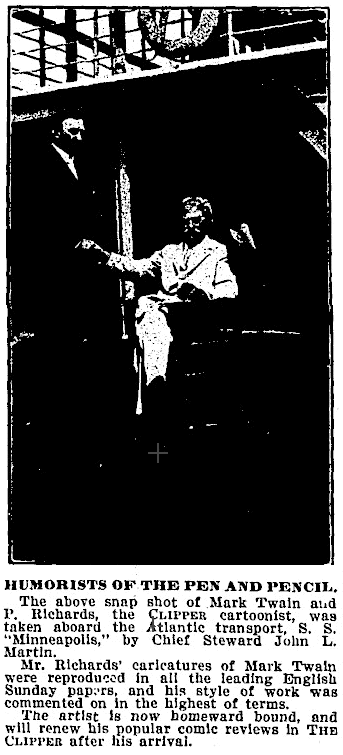
The
New York Clipper,
31 August 1907 |
Searching on ancestry.com
for passports for Richard Pichler revealed a newspaper cartoonist who declared
his alias as P. Richards and his 1914 passport photo matched the previously
published known photos of P. Richards.
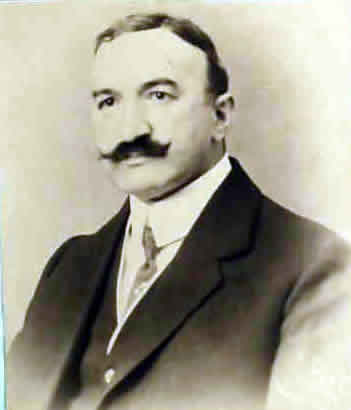 |
 |
Richard Pichler was born in Misliboritz, Austria on 7 July 1868, the son
of Andreas Pichler and Klara Gross. A Roman Catholic, he had come to the
United States in the mid-1880s and became a naturalized citizen in 1893.
He later described his career, "I was rarely in a fixed position, but
a restless 'free-lancer,' seeking to climb as a draftsman and a journalist
a high branch in the forest of Anglo-American newspapers." (Zeichner
und "Gezeichnete", p. 101. English translation by Barbara
Schmidt). Richards's career took him across the United States, and back
and forth to Europe. In 1897 he worked for the William Randolph Hearst chain
of newspapers. In 1900 he was in South Africa. His cartoons and caricatures
documented circuses, vaudeville, the theater, show business personalities
and famous trials.
To glean other details of his personal life, it became imperative to translate
his book. His story revealed that he had made the acquaintance of Ralph
Ashcroft, Samuel Clemens's personal assistant, and that Clemens had written
him a letter inviting him to accompany himself and Ashcroft to England to
document his reception there when he received his Oxford degree. According
to Richards, Clemens had written, "I'll make it worth your while"
(Zeichner und "Gezeichnete", p. 9).
In the summer of 1908, Pichler returned to Berlin, Germany to manage the
foreign office of The New York Clipper. It was in Berlin that Pichler
published two books related to Mark Twain in German. The first, Zeichner
und "Gezeichnete" published in 1912 featured a photo of Mark
Twain and Richard Pichler on the cover with a handwritten inscription signed
"Mark Twain" in the lower right portion.
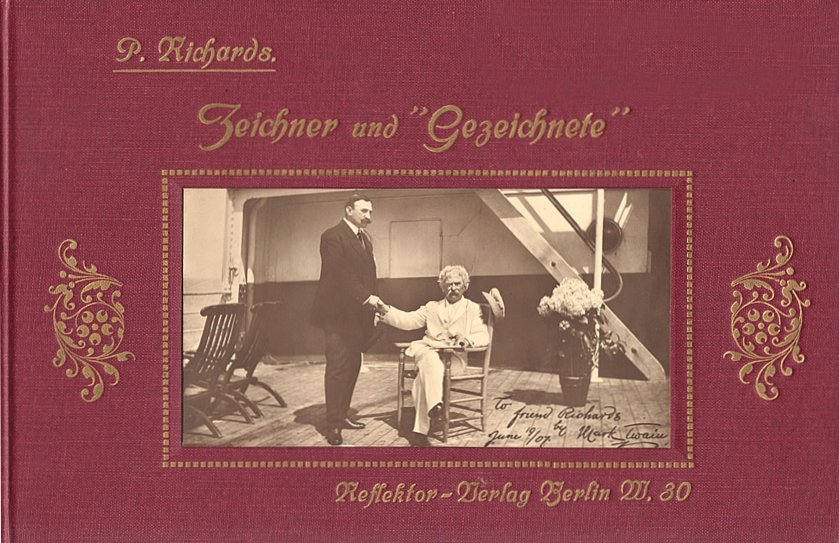
First edition
of Zeichner und "Gezeichnete" (1912)
The book is a collection of memories of the famous people Pichler met and
drew and Mark Twain was the most famous. A landscape format book suited
to reproducing many of the author's cartoons and caricatures, it went through
at least three German editions.
Pichler's second book Mark Twain Anekdoten (Mark Twain anecdotes)
published in 1914 featured the same photo as a frontispiece and contained
many previously published Mark Twain stories and several photos that had
appeared in Albert Bigelow Paine's Mark Twain: A Biography (1912).
However, it featured one significant difference -- the frontispiece featuring
Mark Twain's photo and the handwritten inscription revealed the inscription
was in the upper right to accommodate the vertical portrait format. Closer
comparison of the two separate autographed photographs Richards had used
in his two books revealed slight differences. According to Kevin Mac Donnell,
also a noted authority on forged Mark Twain documents, the inscriptions
on the photos of both books appear to be forgeries. The
original photo thought to have been used in Mark Twain Anekdoten
is currently in the Berg collection of the New York Public Library.
As the years went by after Samuel Clemens's death, Pichler, who was a masterful
promoter, continued to inflate, embroider, and embellish the importance
of his relationship with the famous author. The newspaper and journal articles
he published contained previously published Mark Twain speeches and anecdotes
that he presented as being personally obtained from Clemens. Clemens, on
the other hand, apparently preferred that his connection with the cartoonist
not be acknowledged and purposely kept his name out of his autobiographical
dictation. It is feasible that it was Clemens's idea to recruit P. Richards
to accompany him to Oxford as the cartoonist claimed. It also is likely
that Clemens was disappointed in some of the caricatures that depicted him
as a weeping bald-headed man shorn of hair by his admirers and as a sway-backed
pot-bellied Oxford honoree. Clemens referred to Pichler as a "jack-legged
draughtsman" which implies someone of little talent or worse.
Richard Pichler's memoirs offer an insight into the world of entertainment
in the early 1900s. His descriptions of the Atlantic crossing aboard the
Minneapolis in June 1907 with Mark Twain and Ralph Ashcroft offer
a unique glimpse into Mark Twain's activities on those few days that has
long been available to German readers but has remained unavailable for the
English reading audience until now. His memoir contains only a handful of
insights into his personal life. He was a fan of boxing and wrote, "As
a keen supporter of the boxing sport, there would have been be no significant
match in America for many years, in which I, whether on behalf of my papers,
or as a private person, would not have been present. So I put in, for example,
in 1892, a trip of many thousands of miles to attend the historic meeting
in New Orleans, where on September 7 of that year James Corbett defeated
the former world champion John Sullivan in 21 rounds" (Zeichner
und "Gezeichnete", p. 186). He considered Paul Conchas,
a vaudeville juggler, acrobat, and strongman who died in 1916, his most
intimate friend. Pichler married late in life in 1919 at age fifty-one.
In some cases there are obvious errors in Pichler's memoirs and in a few
instances there are attempts to mislead, not only with regard to Mark Twain,
but other events in his life as well. The irony of Richard Pichler's life
is that he promoted his public alias of P. Richards so successfully that
he managed to obscure his true identity. It has been almost impossible for
later historians to develop an accurate profile of him and include his work
in studies devoted to early cartoonists and humorists. Pichler's date and
place of death have yet to be established.
~~~~~
The following translation from Zeichner und "Gezeichnete"
features editoral comments in blue text within brackets to further identify
people mentioned or to indicate when the author has made a factual error
in his narrative.
DRAFTSMAN AND "DRAWN"
from the memoirs of an American cartoonist and journalist
by P. Richards
Reflektor-Verlag, Berlin (1912)
Translated by Barbara Schmidt
© 2016
MARK TWAIN.
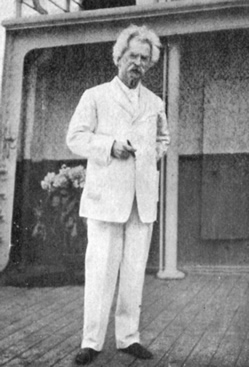
Mark Twain
(Samuel L. Clemens)
We had met repeatedly, a man who was standing in public life and me a newspaper
man. Always the great humorist, the one usually called the "king of
humor" in America charmed me by his friendly courtesy and his kind
interest in my little work. The last time we met at a dinner at the "Engineers
Club" in New York, he wore his famous white flannels that he had shown
the public earlier at a grand reception at the White House in Washington.
"For cleanliness considerations!" Who else but Mark Twain would
be permitted such a display without being decried as eccentric. It was in
the spring of 1907, when I notified Mr. Ralph Ashcroft, Mark Twain's longtime
secretary, who I occasionally saw socially, that I would soon travel to
Europe and would likely order tickets from Low's Exchange. I was happy when
I later received a letter from Mark Twain, in which he indicated in June
he would go to London in person to accept the title of "Doctor of Letters,"
from the University of Oxford. True to the motto, "Lerne zu reisen,
ohne zu rasen" ["Learn to travel, without
having to rush" -- implying "slow enough to let the grass grow"],
he wanted a slow passage on a possible ship of the Atlantic Transport Line.
If I should opt for the same ship, his secretary, the before mentioned Mr.
Ashcroft, would be happy to share his cabin with me.
| P.S. "I'll make it worth your while." I, of course, immediately
made up my mind with the greatest delight. Apart from the financial
benefits, with his influence, a distribution of my Mark Twain sketches
represented a success as I have scored with no other work. Not only
the best British and American papers, but also newspapers like the Melbourne
Punch, Calcutta Advertiser and many others, snatched up these
sketches. |
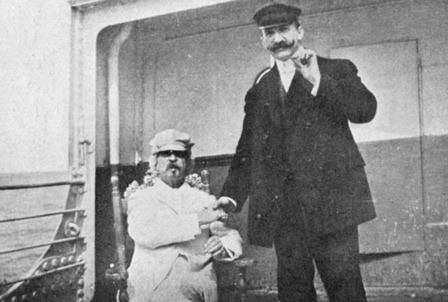
Mark Twain
and me.
To commemorate jointly shared journalistic joys and sorrow. |
When our brave Minneapolis, an efficient vessel in the prime of
life, on a glorious June morning left the port of New York, I met on the
sundeck with the "grand old man" leaning straight against the
railing of the ship, besieged by reporters, convulsively trying to escape
the inevitable interviews to which they pressed him. At Sandy Hook the curious
gentlemen left together with the pilots of the ship. Mark Twain, deeply
moved by his daughter Clara's farewell, looked with a blank expression in
his otherwise lively eyes on the colorful throng of small steamers and sailboats
around that we soon left far behind us to meet only here and there larger
ships of different flags. Incidentally, I beg you not to be frightened:
I would like not to describe the crossing in detail from New York to London,
which I presume to be known, particularly as our Minneapolis neither
collided with an iceberg nor caught on fire. But one way or another, it
was not quite ordinary travel adventures that happened. The importance of
traveling in the presence of Mark Twain, was the most interesting phenomenon
itself, the thought of the other adventures can be shrunk into nothing by
comparison.
Mark Twain had reserved a large part of the rear decks consisting of a
reception room, bedroom and bathroom, for his person. Following this, there
was the cabin that I should share with Mr. Ashcroft during the trip. Since
I felt like no gymnastic feats, Ashcroft took the top bunk which I preferred
to give him, and which he solemnly assured me to be absolutely seaworthy,
and we agreed with regard to the order of dressing and undressing.
The next morning as Mark Twain entered the fresh scrubbed promenade deck
to take his morning walk, he encountered a dense row of hungry eyes that
were directed at him as cannon muzzles on the enemy. But Mark Twain did
not quickly lose his good humor and even encouraged some of the gifted amateurs
to capture him with me on the film. The resulting images, some of which
were excellent, he himself captioned "Two humorists of the pen and
pencil" which various newspapers reproduced with pleasure.
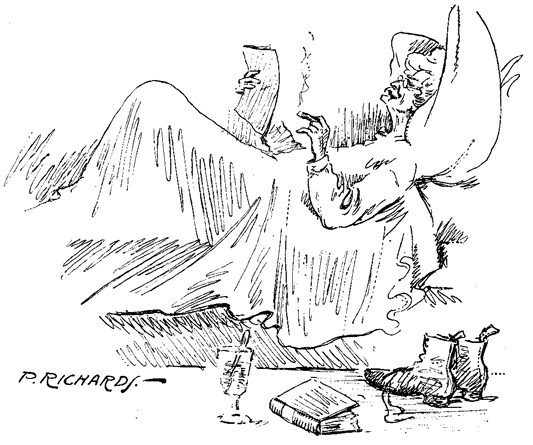
Mark Twain's
favorite pose.
Later in the day Mark Twain devoted himself passionately to
"shuffleboard" or the noble sport of sliding disks. One has nothing
but nothing to do on board, and is mentally jaded with the long and slow
voyage. Mark Twain was a significant example, he was reasonably alive only
when he lit his cigar after dinner in the smoking room. This was also the
time in which I could count on my sketchbook for the richest yield. I could
not wish for a better model than Mark Twain: calm and patient beyond comparison,
with an almost touching, childlike joy of posturing. With great interest
he followed the progress of my work, which he sought to promote in every
way. He gave me his beloved calabash pipe that still adorns my collection
of rarities; I occasionally drew it in his hand. With ruthless candor he
remarked, when the talk turned to the American mind's favorite topic of
making money, about the business success of his works. At the time of our
journey they had already sold more than six million copies in the United
States, apart from the translations that had appeared in no less than eighteen
languages in all parts of the world. The biggest financial success of any
one book except Uncle Tom's Cabin was his Innocents Abroad;
"it sells right along like the Bible," he told me. His Huckleberry
Finn alone, he occasionally noted, had earned him half a million. On
the other hand, they called his books classic. "Classic is a book that
everyone praises, but no one reads," he said.
|
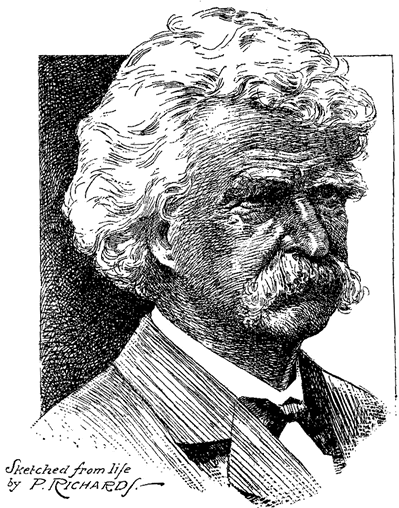
Sketched
from life by P. Richards
|
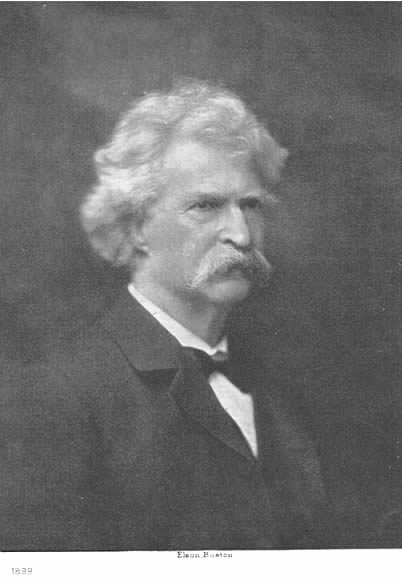 |
[Richards is misleading readers with his caption "Sketched
from life." The illustration is a copy of a photograph of Mark Twain
taken by H. W. Barnett in London in 1899, shown above on the right. It was
used as a frontispiece of How to Tell a Story and Other Essays (1900),
Volume 22 of the uniform edition of Mark Twain's works.]
Although not all jokes that came from him are like Edison inventions, Mark
Twain seldom has a day in which he would not have coined a whole lot of
funny stories. I may presume it is known that the nature of his humor, which
can begin as a funeral march can close with an unexpected Oalopp. He also
swears it is the traditional right of every good humorist to exaggerate.
But not all know that he is a kind man with a deep soul who always remained
faithful to his principle: "The wrinkles on the face of man shall come
only from laughing." His other principle "The truth is the most
precious commodity of man, that is why we should deal with it economically,"
has not a spark of cynicism about it. I do not need to prove it.
His favorite habits -- sleeping and smoking -- he indulged on board. Often
we thought that he was joking when he declared in the brightest sunshine:
"Now I am going to bed." Although he may have often joked, on
this point he was serious. He found the bed rest most conducive to his health
and considered it the best way to keep unwelcome visitors off his neck.
Of course, he did not sleep whenever he lay in bed. I even think that he
used to sleep relatively little because he was always smoking the most serious
cigar of pitch black color. A few times a day his cabin had to be aired,
it was so full of smoke. It was not unusual that Mr. Ashcroft, who supervised
him as a mother would her child, would take the burning cigar out of his
mouth when he made his nightly farewell visit and found him asleep.
Mark Twain had a great love for children and especially for little girls.
He tirelessly wrote autographs and also gave them curls from his long hair.
He had particularly fallen in love with 11 year old Miss Dorothy Quick from
Plainfield (New Jersey), who made the crossing with us and every morning
accompanied him on his promenade, as I have noted in a sketch entitled "Mark
Twain on board the Minneapolis" which appeared on June 19, 1907 in
the Daily Chronicle in London and on 20 July of the same year in
Harper's Weekly in New York. [Richards confuses
Dorothy Quick, 1896-1962 with Carlotta Welles, 1889-1979. Welles was the
little girl who was on the Minneapolis and who was a gifted violinist.
Clemens did not meet Dorothy Quick until the return voyage to America aboard
the Minnetonka in July 1907.] Miss Quick [Miss
Welles] who was a very gifted violinist, played at Mark Twain's request
for a concert to benefit the orphanage fund for seafarers in the Dining
Room and played an excellent piece. [Clemens discusses
this event in his autobiographical
dictation for 24 July 1907.] This event, which tends to be the
highlight of a long trip and is usually degraded to a playground for the
wildest dilettantism, went much better than it usually does in similar situations.
Professor Archibald Henderson, who holds a chair at the University of North
Carolina, has published a long eight columns report of his experience in
the New Yorker Staatszeitung from 1 May 1910, entitled "Mark
Twain, As He Was;" because it also mentions me in the most amiable
manner, I will come back to it. The fact is that this concert, as I said,
over the events of a similar nature to which I was already exposed on my
many voyages, was highly successful.
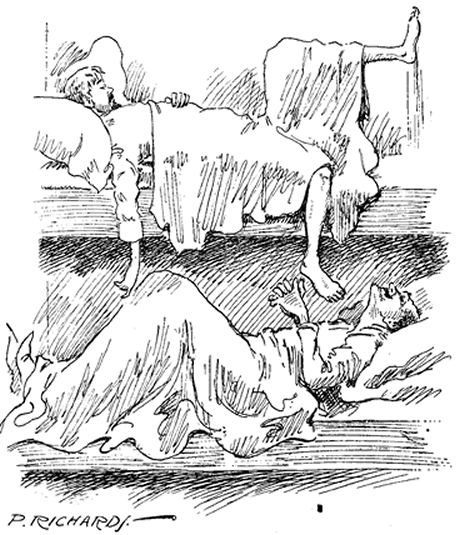
R. W. Ashcroft,
Mark Twain's private secretary, and me in our common cabin.
(Ashcroft above, I below.)
The highlight was, of course, a "handwritten lecture"
by Mark Twain, who performed admirably. It was side-splitting, every word
stretched with funereal mien and pulling, apparently striving laboriously
to find the right expression, pause piled on pause to a sudden, when you
least expected it, hilarious punch line. He was seemingly amazed and surprised
at the laughter and applause around him while the long fingers slowly glided
through his lush white hair, and a clever light in the blue eyes under his
bushy eyebrows twitched on. Other professionals and amateurs followed his
performance. Although the award for best performance was made by the "Meistersinger"
to the Nigger Song, it was far behind Mark Twain's performance. I myself
had at the instigation of Professor Henderson designed a number of Mark
Twain souvenir postcards, although I otherwise on voyages avoid embarrassing
myself by my talent coming under suspicion. [Clemens
discusses this event in his autobiographical
dictation for 24 July 1907.] These small sketches, representing
Mark Twain in all kinds of situations, were hanging for several days on
the "Lost and Found" bulletin board, which was located at the
entrance to the dining room. We intended to let them be auctioned by Dr.
F. L. Patton, Rector of the University of Princeton, "by raffle."
The speculation was not bad, because we achieved prices which exceeded our
wildest expectation. Especially the first card of the series which was bid
up outrageously by a certain Mr. Thompson [Robert
Henry Thompson, 1841-1910] and achieved a price for which you
can get a royal image in a downright genuine gold frame. But even the next
cards found enthusiasts at prices that caused me to blush. Only then could
I see how much wealth was actually present on the ship.
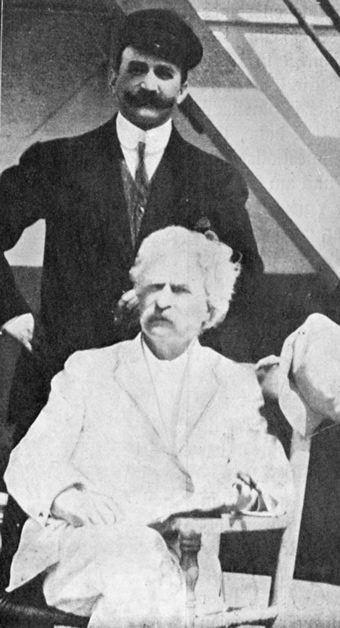
"Two
humorists of the pen and pencil"
Naturally, Mark Twain was mobbed for autographs by everyone who had bought
my cards. One episode, which took place on this occasion will be unforgettable
to me. A Mrs. X., had purchased the card No. 6, which represented Mark Twain,
as he came with abundant hair on the ship, and how he had then been plucked
bald by his admirers, insisted that Mark Twain write more than "merely"
his name on "her" card, noting it had been purchased at an ignominious
catapult price. Mark Twain fought tooth and nail. It would not be fair,
he said, to grant her more than all the others. But the lady would take
no refusal and stubbornly insisted on "a little rhyme" and continued.
Nothing helped Mark Twain. The gun was at his chest with the words: "You
will not refuse a lady, Mr. Twain, will you? Please write just one word!"
To which Mark Twain wrote with a cold smile: "1 word Mark Twain."
Since we produced customized photographs of all the cards, I am in a position
to thereby reproduce the classic card here.
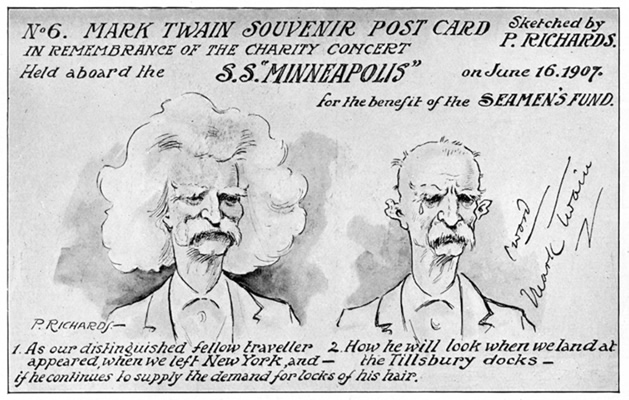
Mark Twain,
as he was, and how his admirers have now worked him.
No. 6 of Mark Twain card series for the benefit of the Seaman's Fund.
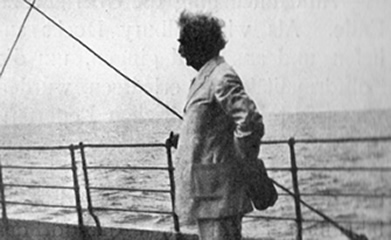 Mark
Twain's silhouette.
Mark
Twain's silhouette.
(Photographed at sunset.) |
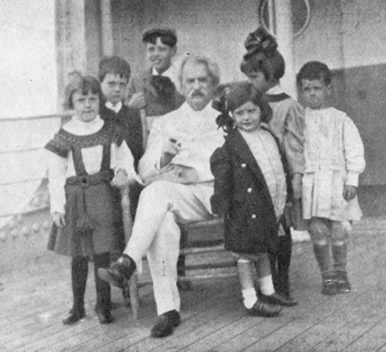
"Suffer
the little children to come unto me." |
| An American magazine of the temperance
movement proclaimed the other day that Mark Twain was a "total
abstainer" (absolutely Never drank). I do not want to let the opportunity
pass without contradicting this assertion emphatically because, unless
Mark Twain was asleep, he was anything but an enemy of alcohol and was
not without his "toddy" prepared for him by Mr. Ashcroft nightly.
Also during the day he would agree to drink some, albeit usually not
in public. When the first officer, the ship's doctor, Ashcroft and I,
one evening in Mark Twain's cabin sat together in stimulating conversation
and forgot that it was time for the old man to go to bed. Mark Twain
rose and told us his "toddy" custom: "and now, Ralph,
bring me my toddy" he concluded, turning to Mr. Ashcroft. We took
the hint and disappeared. I was later honored by Mark Twain to join
at the evening "toddy." The brew tasted so good that I drank
something more than I could bear. In the morning I woke up with a terrible
hangover and sent word to Mark Twain by Ashcroft that I had an "eye-opener"
-- I had "renounced." Then I received, written on the ship's
letterhead, the following sentence: "Taking the pledge will not
make bad liquor good, but it will improve it" (by a long stretch). |
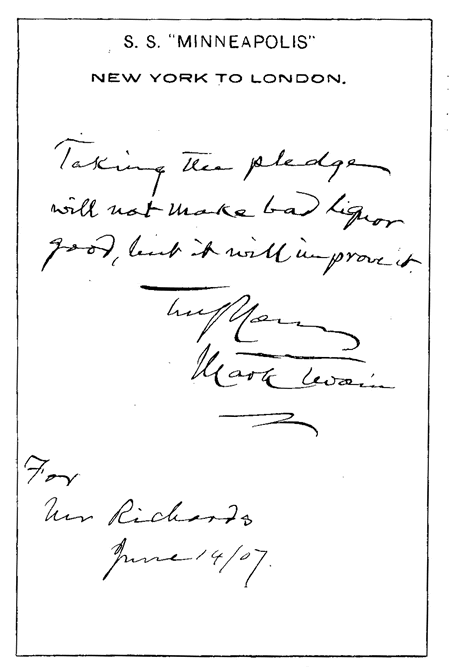
A jocular
tribute by Mark Twain. |
Gradually the crossing ended. As we walked ashore at Tillbury docks and
went to complete the customs formalities, we were immediately surrounded
by British reporters and photographers who followed on our heels to Saint
Pancras Station, since they had received information that there the famous
British satirist and playwright Bernard Shaw was waiting to receive Professor
Henderson, who had come to write his biography. The gentlemen were naturally
excited about the meeting between Mark Twain and Shaw, but nothing particularly
exciting happened since the meeting was limited to exchanging a few compliments.
Once in London, Mark Twain stayed with Mr. Ashcroft at Brown's Hotel at
Albemarle Street, while I was welcomed in the lovely villa of my old friend
Cinquevalli [Paul Cinquevalli, 1859-1918] on
Brixton Road. Still, I was a day guest of Mark Twain, with whom I now soon
plunged into the succession of feasts and banquets of all possible varieties
that awaited us. A lunch at the Pilgrim's Club at the Savoy Hotel, a dinner
with Punch editors, a banquet with Whitelaw Reid, the US ambassador at Dorchester
House, festivities in the "Savages" and "Bath" Clubs,
came one other after and then the ceremonial appointment of Mark Twain as
"Doctor Of Letters" at Oxford. He was overcome with happiness
at his new doctor robe, in which he marched proud as a peacock. I have the
memorable moment recorded in all sorts of formal sketches and caricatures.
The climax of Mark Twain's London sojourn followed on June 22: the reception
before the King. The outstanding London daily newspaper in large sized headlines
announced as follows: "Mark Twain received by the King! God save the
King!"
The reception itself was at a garden party at Windsor Castle. King Edward
and Queen Alexandra chatted a long time in the most excited way with Mark
Twain. We observed the group at a respectful distance and concluded from
the frequent laughter of the high pair that Mark Twain's humor had gone
over well. But with the nervous play of his hands, which he hid behind his
back, we noticed that he was apparently not quite as calm as usual.
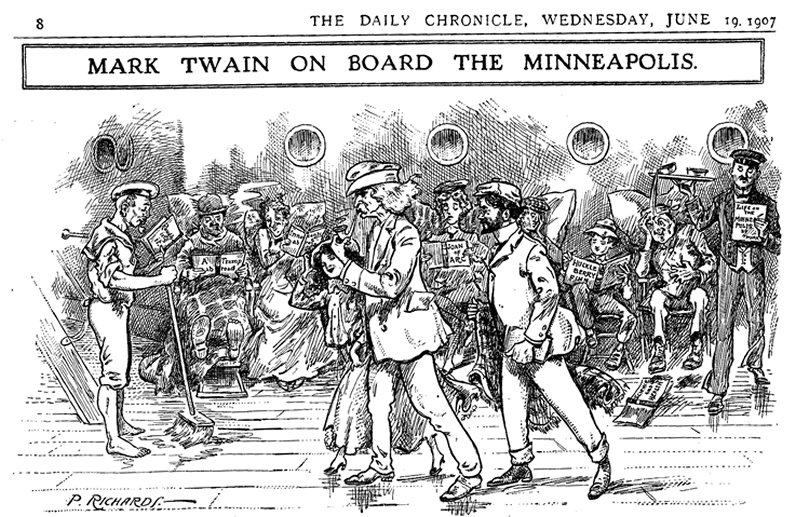
Mark Twain
on Board the Minneapolis.
(With permission from The Daily Chronicle, London and Harper's
Weekly, New York)
[The above cartoon is a revised one
and different from the one that originally appeared in 1907.
This revised version more clearly presents the face of Carlotta Welles and
features different background characters.]
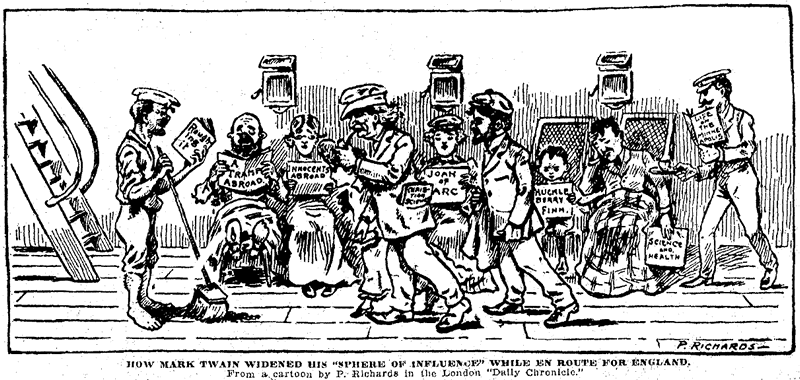
[Original version of the previous cartoon.]
Soon after, I said goodbye to Mark Twain and Ashcroft, to
escape to Europe from the grueling festivities that were still far from
waning. Mark Twain regretted exceedingly not being able to be of my party;
particularly going to Berlin and Vienna. He had many fond memories of both
cities. Berlin, he said, was ruled as no other city when he had visited
it in 1891. He spoke with extraordinarily deep reverence about the German
emperor, who received him at the time and had made such a huge impression
on him that he forgave him, the "many rules" and found that nobody
could rule better. In Vienna, Mark Twain had been a long time in 1897, for
his daughter Clara took piano lessons with Professor Leschetizky. Mark Twain
had been staying at the Hotel Metropole. To commemorate his stay in Vienna
he brought his friends the candles for which he had been billed.
Later I was privileged several times to see Mark Twain and
enjoy his company. The last message that I received from him was dated from
Bermuda, where he was staying as a guest of the American Vice-Consul W.
H. Allen. At that time he invited me to visit him at his villa Stormfield
in Redding to draw portraits of his beloved "Kitties" and his
German police dog "Fix." His housekeeper Katy would, so he wrote
to me, cook my favorite dish "Noodles" (macaroni). I would certainly
come, he wanted my opinion as to whether some originals by me would be good
to hang in his billiards room. Unfortunately this invitation was not granted
to me to follow. Soon after, I received -- on German soil -- a letter Mr.
Ashcroft confirming the sad news of Mark Twain's death, which had already
been reported in the newspapers.
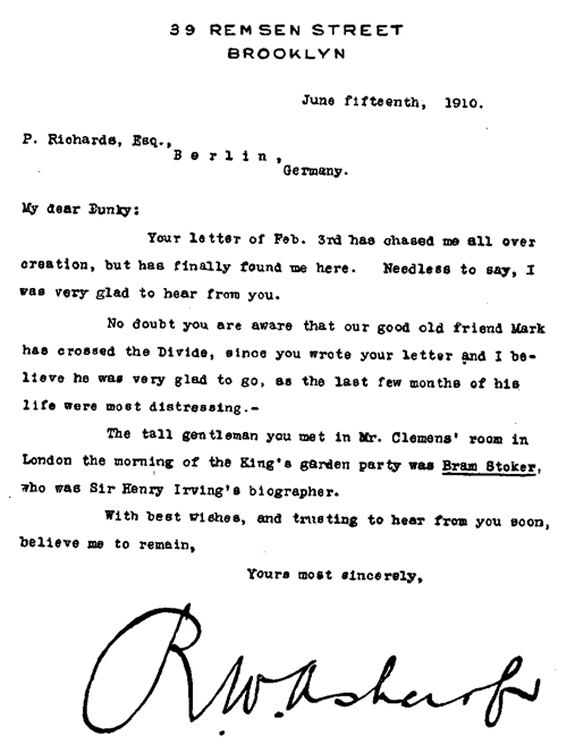
Ashcroft announces
the death of Mark Twain
While I write this line, I have Mark Twain's picture on my desk. I look
at the familiar features and remember him with deep emotion and gratitude.
I hear New York wants to put a magnificent marble monument to him, designed
by my great countryman Potter, which shall bear the inscription: "the
greatest explorer of human nature." [Potter has
not been further identified. He may be either Edward Clark Potter, 1857-1923
or Louis McClellan Potter, 1873-1912]. Why and to what extent has
he earned this designation? I myself do not want to judge him, for he is
much too close to me.
On one occasion many years ago, when Mark Twain was still alive and enjoyed
the best of health, gossip pages brought the news of his death, he told
the reporters, who had come to inquire about his final hours: "You
telegraph your journal that the rumor is greatly exaggerated."
Now it's come true, the rumor, and he is there in the little cemetery of
Elmira. But we who know him, do not stop to mourn his end, and are soothed
just at the thought of his work, which brings tears of joy rather than tears
of sadness.
